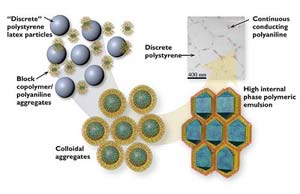Latest News

Atomic force microscope powerful new tool for measurement of particle attraction
Aim is better filters for contaminants
Tracy L. Cail, a Ph.D. student in geological sciences at Virginia Tech, is developing a new method for calculating sticking efficiency at the nanoscale with the aim of someday developing improved filters for removing contaminants from solutions, such as bacteria from groundwater. She will present her research at the 225th American Chemical Society national meeting March 23-27 in New Orleans.
In the past, scientists have used theoretical

Methanol could fuel computers, cell phones
Because methanol, as a liquid, would be easier to dispense using current infrastructure, it will likely be one of the first fuels for fuel cells.
Speaking at the 225th national meeting of the American Chemical Society March 23-27 in New Orleans, Yu Seung Kim, a former research scientist at Virginia Tech, will report the results of studies at Virginia Tech to determine the optimum materials for use as a proton exchange membrane in a methanol-based fuel cell.
Methanol is the

The spice of life: Antibody cocktail targets deadly foodborne germs
In the future, consumers may be adding a powerful “spice” to their food that could save lives. Researchers in Canada are developing a natural antibody cocktail that can help prevent the most common foodborne germs, including E. coli and Salmonella, which cause thousands to become sick or die each year in this country.
Derived from freeze-dried egg yolk, the substance is nicknamed a spice because it can be sprinkled or sprayed onto meats, fruits and vegetables to complement existing sanitati

Rutgers researchers test polymer reliability for medical implants
Sascha Abramson has been investigating new methods to ensure that polymer medical implants in the human body don’t fail. Abramson looked at degradable polymers, ones the body can ultimately absorb, to gain a deeper understanding of how and why their structures change – crucial parts of a puzzle that must be solved for polymers to perform predictably and successfully in medical implants.
Her research was conducted as a postdoctoral associate at Rutgers’ New Jersey Center for Biomaterials in

Mayonnaise as Model for Solid Plastics
Intriguing Structural Strategy Aims at Making Designer Plastics Affordable
The future was supposed to be “plastics,” according to advice given in a 1960s movie The Graduate. Many a company thought that future meant the gradual ascendancy of “designer” or specialty plastics, but almost 40 years later the market is still dominated by plastics that can be manufactured cheaply in bulk.
Six researchers from the University of California at Santa Barbara (UCSB) and one at Helsinki U

Fire Frequency Determines Forest Carbon Storage
Scientists studying trees ranging from saplings to 130 years old in Canada’s northern forests have discovered that the period since a fire last swept through an area determines how much carbon the forest can store. Twenty to forty year old stands absorb more carbon than those 70 years old and older, despite being smaller and having less biomass or plant material.
Boreal or northern forests account for close to 25 percent of total carbon stored in vegetation and soils in the Earth’s biospher











